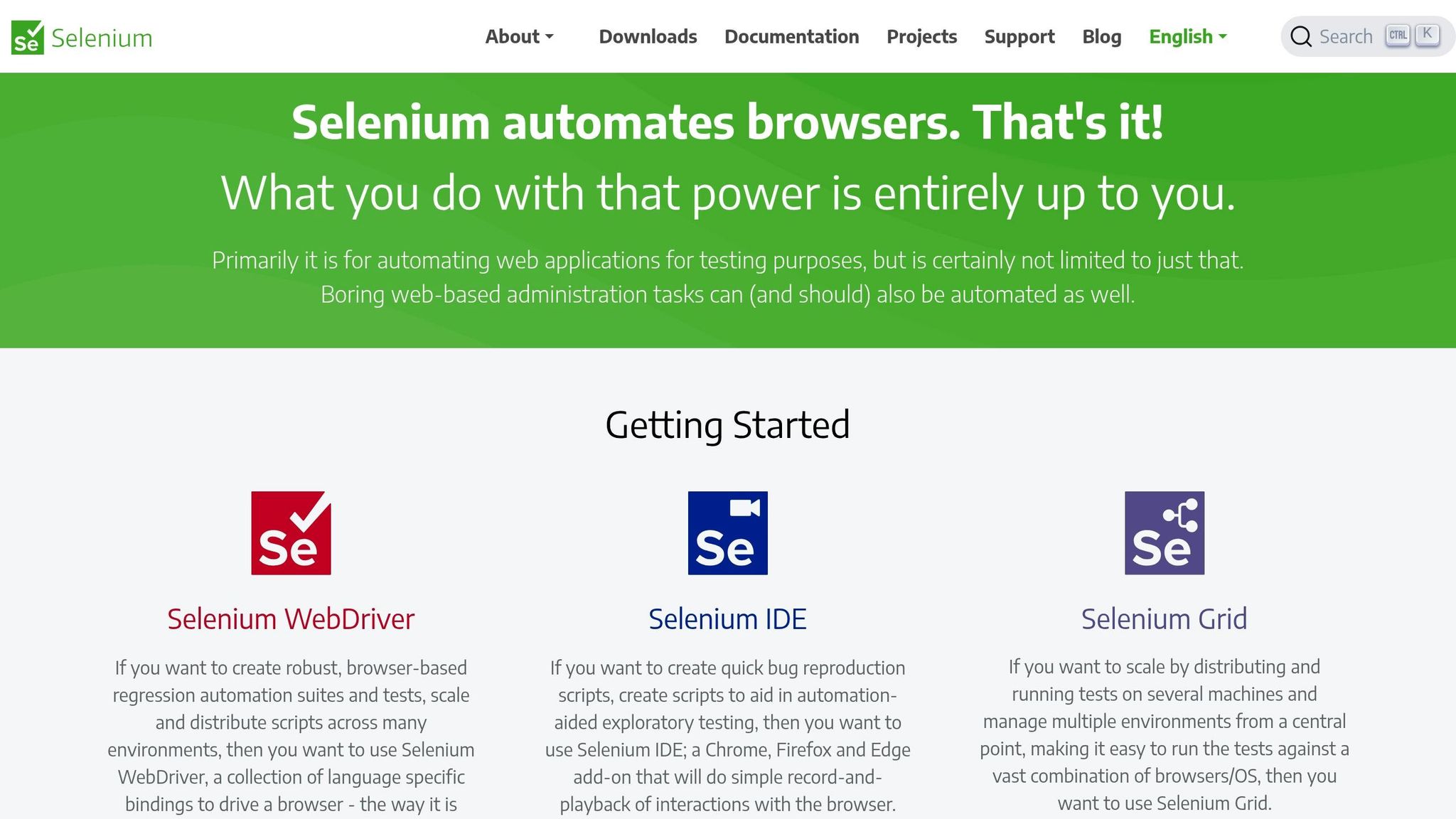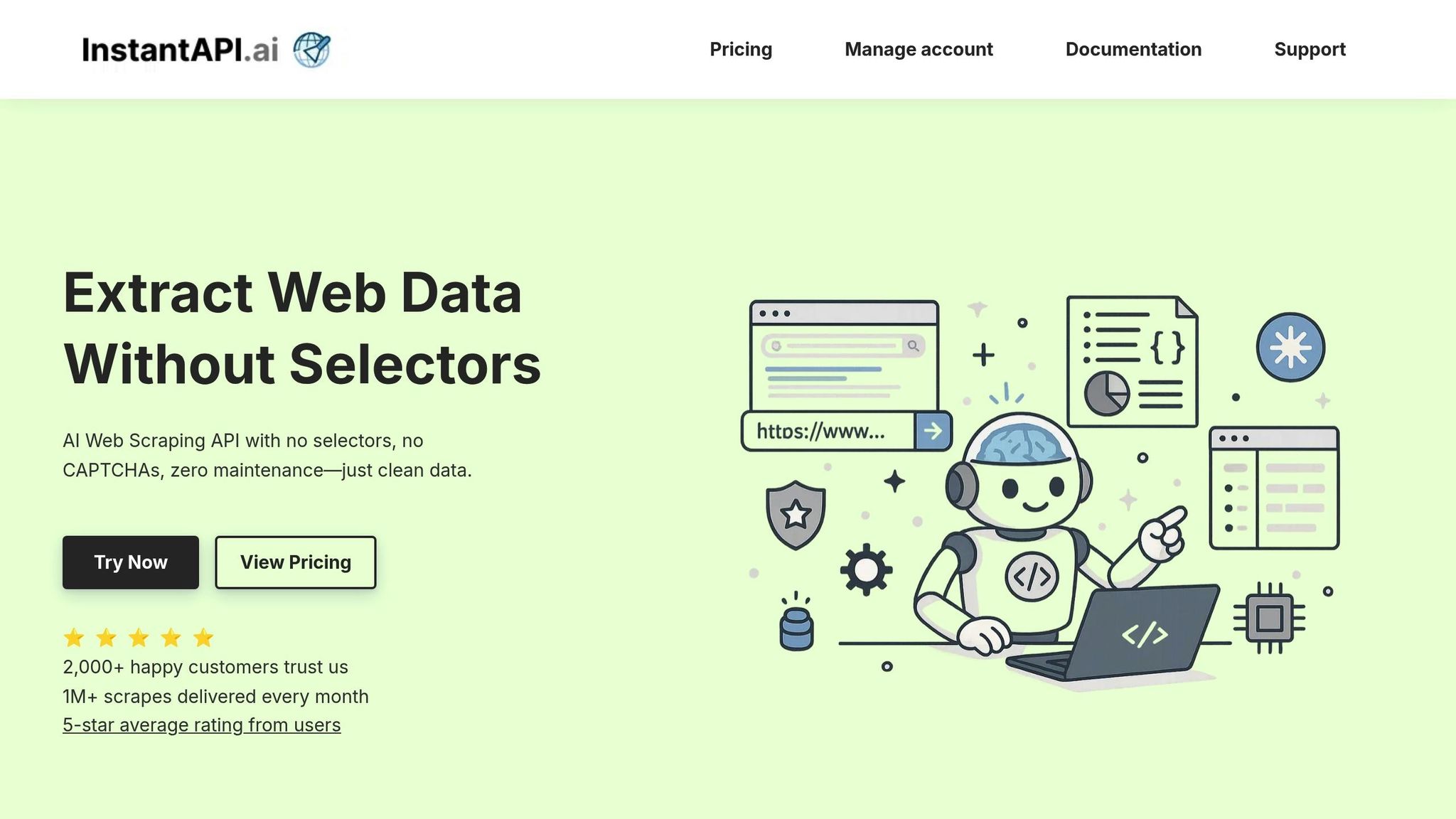Web scraping is a game-changer for freelancers, automating data collection from websites to analyze markets more efficiently. By replacing manual tasks like monitoring competitor prices or tracking trends, freelancers can save time and deliver more actionable insights. Here's why it matters:
- The web scraping market is valued at $1.03 billion in 2025, with a projected annual growth rate of 14.2%.
- Freelancers specializing in data analysis earn 40% more than those offering basic scraping services.
- Tools like BeautifulSoup, Scrapy, Selenium, and InstantAPI.ai make scraping accessible, even for complex tasks.
Legal and ethical compliance is critical - freelancers must respect website rules, avoid personal data, and follow regulations like CCPA. The right tools and strategies can help overcome challenges like website changes and anti-bot protections. By focusing on automation, data cleaning, and ethical practices, freelancers can offer premium services to industries like e-commerce, real estate, and finance.
How to Scrape Data for Market Research (full project)
Web Scraping Tools for Freelancers
Picking the right web scraping tool can make a big difference in how fast you complete a project, how much upkeep it requires, and how profitable it ends up being. The size and complexity of your task should guide your choice, as these tools form the backbone of the market analysis process outlined in the next section.
BeautifulSoup and Scrapy: Python-Based Solutions

BeautifulSoup is a go-to option for extracting data from HTML and XML. It’s ideal for smaller projects where you need to pull specific information quickly - like checking competitor prices or gathering contact details from a directory. Its ease of use means you can start scraping with just a few lines of code. However, it does require additional libraries like requests for fetching web pages and struggles with handling large volumes of data efficiently.
Scrapy, on the other hand, is a more robust framework designed for large-scale scraping. It handles asynchronous requests, allowing you to process thousands of pages at once. Features like middleware and extensions make it easier to manage cookies, handle redirects, and deal with pagination. This makes Scrapy perfect for complex tasks like monitoring pricing trends across multiple competitors or large e-commerce platforms. Both tools, however, need manual updates when websites change layouts and aren’t equipped to handle JavaScript-heavy content or advanced anti-bot systems.
Selenium for Dynamic Websites

When dealing with websites that rely on JavaScript to load content, Selenium is the tool you need. It operates by controlling an actual browser, rendering pages just as a human user would. This allows Selenium to handle dynamic content and simulate user actions like clicking buttons, filling out forms, and scrolling through pages.
"Selenium lets me interact with web pages just like a regular user would. I can click buttons, fill out forms, and even handle content that loads after the page has initially loaded. It's especially useful when I need to scrape data from complex websites that other tools can't handle."
– Data Journal
While incredibly versatile, Selenium is resource-intensive. Running multiple browser instances can eat up memory and CPU power, and its slower speed might be a drawback for high-volume scraping tasks.
InstantAPI.ai: No-Code Scraping with Flexible Pricing

For freelancers looking to avoid the hassle of constant maintenance, InstantAPI.ai offers a no-code solution that simplifies the entire process. You just define the data you need in JSON, and the tool takes care of the rest. It handles anti-bot measures, proxy rotation, and JavaScript rendering automatically, ensuring seamless scraping even when websites update their defenses or layouts.
What makes InstantAPI.ai stand out is its pay-per-use pricing model: you pay only $2 for every 1,000 pages scraped, with no minimum spend. This makes it an excellent choice for freelancers, whether you’re working on small research projects or large-scale competitive analyses.
"After trying several other solutions, we were won over by the simplicity of InstantAPI.ai's Web Scraping API. It's fast, straightforward, and lets us focus on our core features."
– Juan, Scalista GmbH
InstantAPI.ai also offers specialized endpoints to streamline your tasks:
/scrapedelivers structured JSON from any page./linksextracts hyperlinks based on plain-English descriptions./nextfinds pagination URLs automatically./searchhandles Google SERP data with location-specific results.
With no need for manual updates, InstantAPI.ai eliminates the headaches of maintaining traditional scrapers. As websites evolve and introduce new anti-bot measures, this tool adapts on its own, keeping your data flowing without interruptions. Plus, its pricing structure avoids the hidden costs often associated with traditional tools, such as monthly minimums or additional fees for proxies and CAPTCHAs. For freelancers, it’s a time-saving and cost-effective choice that allows you to focus on delivering results.
Step-by-Step Guide to Market Analysis with Web Scraping
Turn raw data into actionable market insights by following a structured process that avoids common missteps.
Finding and Choosing Data Sources
The success of your market analysis hinges on the quality of your data sources. Reliable data starts with carefully evaluating potential websites to ensure they align with your goals.
Begin by identifying websites that directly support your analysis objectives. For example:
- Competitive pricing research: Focus on e-commerce platforms, manufacturer websites, and industry marketplaces.
- Trend analysis: Look to news sites, industry publications, and social media platforms.
Websites that rank high in search results for relevant keywords often indicate authority and reliability, so prioritize those. When assessing potential sources, keep an eye out for:
- Design and maintenance: Clean, simple designs often reflect well-maintained sites run by established organizations.
- Update frequency: Avoid sites that haven’t been updated in months; fresh data is critical.
- Technical quality: Check for broken links or outdated content, as these can signal poor maintenance.
Manually review sample pages to confirm the data aligns with your needs. This step ensures you don’t waste time on sources that appear promising but fail to deliver relevant information. Once you’ve confirmed reliable sources, you can move on to automating the data collection process.
Setting Up and Automating Data Collection
Automation streamlines the process of gathering data consistently, saving time and effort. The tools and methods you choose will depend on the scale of your project and your technical preferences.
For simple task automation, use Python's schedule library. Install it with:
pip install schedule
Here’s an example of a basic scheduling script:
import schedule
import time
def job():
current_time = time.strftime("%H:%M:%S")
print(f"{current_time}: Running scheduled task...")
schedule.every().hour.do(job)
while True:
schedule.run_pending()
time.sleep(1)
For more advanced setups, use asyncio for concurrent scraping. This approach improves resource management and allows smoother error handling:
import asyncio
import time
async def schedule_scraper(interval_hours: float = 1):
while True:
try:
print(f"Starting scrape at {time.strftime('%Y-%m-%d %H:%M:%S')}")
# Your scraping logic here
print("Data collection completed")
except Exception as e:
print(f"Error during scraping: {e}")
await asyncio.sleep(interval_hours * 3600)
async def main():
tasks = [schedule_scraper(interval_hours=1)]
await asyncio.gather(*tasks)
if __name__ == "__main__":
asyncio.run(main())
For freelancers or those managing multiple projects, cloud-based solutions like GitHub Actions are a great option. They allow you to schedule tasks without relying on your local machine:
name: Market Data Scraper
on:
schedule:
- cron: "0 */6 * * *" # Runs every 6 hours
workflow_dispatch: # Allows manual trigger
jobs:
scrape:
runs-on: ubuntu-latest
steps:
- uses: actions/checkout@v3
- name: Set up Python
uses: actions/setup-python@v4
with:
python-version: "3.9"
- name: Install dependencies
run: |
python -m pip install --upgrade pip
pip install requests beautifulsoup4
- name: Run scraper
run: python market_scraper.py
When automating, always include rate limiting and delays to avoid overwhelming target websites. Use proxy rotation to prevent IP blocking, and implement logging to track errors and performance.
If you’re using InstantAPI.ai, automation becomes even simpler. The platform handles proxy rotation, rate limiting, and anti-bot measures for you. Here’s an example:
import requests
def scrape_competitor_data():
url = "https://api.instantapi.ai/scrape"
payload = {
"url": "https://competitor-site.com/products",
"format": "json",
"fields": {
"product_name": "string",
"price": "number",
"availability": "string"
}
}
response = requests.post(url, json=payload)
return response.json()
Automation connects your chosen data sources with efficient, precise data collection processes.
Cleaning and Organizing Data for Analysis
After gathering your data, the next step is cleaning and structuring it for accurate analysis. Clean data ensures your insights are reliable and actionable.
Start by eliminating duplicates, which often occur when scraping multiple pages or running repeated collections. Use unique identifiers like product SKUs, URLs, or timestamps to identify and remove duplicates. Address missing data systematically - either exclude it, assign default values, or interpolate based on your analysis needs.
Standardize formats for consistency:
- Convert prices to formats like $1,234.56.
- Normalize dates to MM/DD/YYYY.
- Ensure numerical data uses correct decimal separators.
Organize your cleaned data in formats tailored to your analysis tools. JSON works well for hierarchical data or API integrations, while CSV files are ideal for spreadsheets and statistical software. For more complex analyses, divide data into categories (e.g., pricing, product details, competitor information) but maintain consistent identifiers for easy cross-referencing.
Be mindful of sensitive or proprietary information during the cleaning process. Remove any personally identifiable details, internal codes, or other data that shouldn’t be part of your analysis.
Set validation rules to catch potential errors early. For instance:
- Ensure prices aren’t negative.
- Verify dates aren’t in the future.
- Flag unusual patterns that might indicate scraping issues.
Finally, document your cleaning process. Include details like transformation rules, excluded data, and quality checks. This documentation is invaluable for explaining your methods to clients or troubleshooting unexpected results during analysis.
Investing time in cleaning and organizing data pays off during analysis, enabling faster decisions and more accurate insights.
sbb-itb-f2fbbd7
Common Web Scraping Problems and Solutions
Web scraping can come with its fair share of challenges, especially for freelancers. These issues can slow down your projects, eat into your profits, and make your work more frustrating than it needs to be. But if you know how to tackle these problems effectively, you’ll keep your projects running smoothly and your clients happy.
Handling Website Layout Changes
One of the most common headaches in web scraping happens when websites update their design. Even small changes, like switching a product price element from <span class="price"> to <div class="product-price">, can break your scraping scripts overnight.
Most scraping tools rely on CSS selectors and XPath expressions to pinpoint specific elements on a webpage. When the structure changes, those selectors stop working, and you’re left scrambling to fix them.
To make this process less painful, consider using a modular code design. By storing your selectors in a separate configuration file, you can quickly update them without touching your main scraping logic. Here’s an example:
# config.py
SELECTORS = {
'product_name': '.product-title h1',
'price': '.price-current',
'availability': '.stock-status'
}
# scraper.py
from config import SELECTORS
def extract_product_data(soup):
return {
'name': soup.select_one(SELECTORS['product_name']).text,
'price': soup.select_one(SELECTORS['price']).text,
'stock': soup.select_one(SELECTORS['availability']).text
}
This approach saves time and keeps your code cleaner. But layout changes aren’t the only obstacle - you’ll also need to deal with anti-bot systems.
Getting Past Anti-Bot Protection
Websites don’t make it easy for scrapers. Anti-bot measures like IP bans, CAPTCHAs, and rate limits are designed to stop automated tools in their tracks. When these protections kick in, your scraper can grind to a halt unless you’re prepared.
Here are a few ways to stay ahead of anti-bot systems:
- Proxy rotation: Spread your requests across multiple IP addresses to avoid detection. Residential proxies work better than datacenter proxies because they’re harder to identify as bots.
- User agent rotation: Switch up your user agent strings to mimic different browsers and devices. This makes your requests look more like they’re coming from real users. For example:
import random
USER_AGENTS = [
'Mozilla/5.0 (Windows NT 10.0; Win64; x64) AppleWebKit/537.36',
'Mozilla/5.0 (Macintosh; Intel Mac OS X 10_15_7) AppleWebKit/537.36',
'Mozilla/5.0 (X11; Linux x86_64) AppleWebKit/537.36'
]
headers = {'User-Agent': random.choice(USER_AGENTS)}
- Random delays: Add pauses between requests to mimic human browsing behavior. This reduces the chances of triggering rate limits or other anti-bot defenses.
CAPTCHAs, however, are a tougher nut to crack. Solving them often requires specialized services, which can increase costs and complexity.
Reducing Maintenance Work
Keeping scrapers running smoothly takes effort. You’ll need to update selectors, manage proxies, and troubleshoot server problems - all of which can eat into your productivity. And as you scale up your scraping efforts, the workload only grows.
Each website comes with its own quirks, so robust error handling and recovery systems are essential. Setting up monitoring and alerting tools can help you quickly spot when something goes wrong, minimizing downtime and keeping your projects on track.
Another key consideration is compliance. According to recent surveys, 68% of organizations worry about the legal and ethical implications of data collection. To stay on the right side of the law, make sure your scrapers respect robots.txt files, maintain reasonable request rates, and avoid collecting sensitive or restricted data.
If all of this sounds like a lot to manage, there are tools available to simplify the process. For example, InstantAPI.ai takes care of the heavy lifting by handling infrastructure, anti-bot measures, layout changes, and more. With pricing at $2 per 1,000 pages scraped and no minimum spend, you only pay for successful data extraction. The service manages proxy rotation, CAPTCHA solving, JavaScript rendering, and selector updates, letting you focus on analyzing data instead of maintaining scrapers.
Legal and Ethical Web Scraping Guidelines
Web scraping operates in a tricky legal space, and freelancers need to understand the rules to avoid potential pitfalls. While the act of scraping itself isn't illegal in the United States, the way you gather, use, and store data can lead to legal complications. Knowing where the boundaries lie is essential to protect yourself and your clients from disputes. Legal compliance goes hand in hand with technical precautions, creating a well-rounded approach to responsible scraping.
"One question everyone asks prior to commencing their web scraping journey is 'is web scraping legal?' The short answer is that web scraping itself is not illegal." - Zyte
Key legal areas that intersect with web scraping include copyright laws, contract agreements, data protection regulations (like the California Consumer Privacy Act, or CCPA), and anti-hacking statutes. Although recent court rulings have clarified some gray areas, freelancers must still tread carefully.
Following Robots.txt and Website Terms
Legal guidelines add another layer to the technical best practices of web scraping. A website's robots.txt file is often the first indicator of what automated tools can or cannot access. Found at the root of most websites (e.g., example.com/robots.txt), this file outlines which parts of a site are off-limits. Ignoring these instructions can lead to legal trouble, even if the data is publicly visible.
Always review the robots.txt file before scraping. Look for "Disallow:" directives, which indicate restricted paths. For instance, if you see "Disallow: /" under "User-agent: *", the site prohibits all automated access. Some sites may have specific rules for different bots, so read the entire file carefully.
Terms of Service (ToS) agreements often carry even more legal weight than robots.txt files. Many websites explicitly ban automated data collection in their terms, and violating these conditions could result in breach-of-contract claims. A notable example is the LinkedIn v. hiQ Labs case, where the court acknowledged that accessing publicly available data might be lawful, provided it aligns with the website's terms.
Before scraping, always review and save the website's Terms of Service. Look for clauses mentioning "scraping", "data mining", or "automated access." If these activities are prohibited, either request permission or find alternative data sources. Document your review process to show good-faith compliance if any issues arise later.
Avoiding Personal and Private Data
Scraping personal data requires extra caution. Laws like the CCPA impose strict rules on how personal data is collected, stored, and used. Personal information goes beyond names and emails - it can include IP addresses, device identifiers, and even browsing habits.
To minimize risks, focus on scraping publicly available business data, such as product prices, job postings, or company contact details. These types of data generally come with fewer legal complications compared to personal user profiles, reviews with identifiable details, or social media content. If personal data is unavoidable, use filtering systems to exclude sensitive information before storing it.
Consent is another important factor. Just because personal data is visible online doesn’t mean users have agreed to its collection or repurposing. Social media platforms, forums, and review sites often contain information shared for specific contexts, not broad commercial use.
Create clear data collection policies for your freelance operations. Define what you will - and won’t - collect, explain how you’ll handle any personal data captured unintentionally, and outline your procedures for data deletion. Sharing these policies with clients upfront sets clear expectations and demonstrates your ethical approach.
Maintaining Data Quality and Legal Compliance
Low-quality data can hurt your reputation and lead to legal headaches. On average, organizations lose $12.9 million annually due to poor data quality. Even small errors can damage client relationships or result in legal liability.
Use validation systems to ensure the accuracy of the data you collect. Check that numbers fall within logical ranges, dates are formatted correctly, and contact details seem valid. Cross-check your data with trusted sources whenever possible, and flag any major inconsistencies for further review.
Establish clear data retention policies to stay compliant with regulations and manage storage efficiently. Set timeframes for retaining different types of data and consider automated deletion systems. In many cases, processed insights and trends are more valuable than raw data, so there’s no need to hold on to everything.
Documentation is also key. Keep detailed records of your data sources, collection methods, and any permissions obtained. Log your review of robots.txt files and Terms of Service agreements to show your professional diligence if questions arise.
Regular compliance audits are a proactive way to catch issues before they escalate. Periodically review your scraping practices for changes in website terms, updates to data protection laws, or new legal requirements. Staying vigilant helps you adapt to the ever-changing legal landscape of web scraping.
It’s worth noting that 68% of organizations express concerns about the legality and ethics of their data collection methods. By prioritizing compliance and data quality, you not only safeguard your business but also build trust with clients who value responsible practices. A strong commitment to these principles ensures your scraping activities remain effective and within legal bounds.
Conclusion: Using Web Scraping to Improve Your Freelance Business
Web scraping has revolutionized how freelancers tackle market analysis, turning weeks of manual research into hours of automated data collection. With the global web scraping services market projected to hit $1.71 billion by 2027, growing at a 10.1% annual rate, it's clear that demand for these skills is on the rise.
For freelancers, this means an opportunity to go beyond just gathering data. By offering services like competitor monitoring, product trend analysis, and market sentiment tracking, you position yourself as a strategic partner - someone who helps businesses make smarter decisions.
"Web scrapers are your ticket to automating tedious data collection tasks. This translates to significant time savings, allowing you and your team to focus on more strategic activities." - Hafiz W., Freelance Web Scraper
Pairing technical scraping expertise with analytical insights can elevate your offerings, enabling you to charge premium rates. Tools like InstantAPI.ai make this even more accessible with pay-per-use models, removing the infrastructure challenges that often come with web scraping.
Ethical practices are also becoming a key selling point. With 73% of companies emphasizing ethical considerations when hiring scraping services, adhering to guidelines like respecting robots.txt files, following Terms of Service, and steering clear of personal data collection isn't just about compliance - it’s a way to stand out in the market.
Targeting high-demand industries such as e-commerce, real estate, financial services, and market research can further enhance your value. Offering tiered service packages - from basic data extraction to in-depth market analysis - can attract a range of clients. Retainer agreements for ongoing monitoring not only provide steady income but also foster long-term client relationships.
As the technology behind web scraping evolves, user-friendly, cloud-based solutions are taking over, allowing freelancers to focus on delivering insights instead of wrestling with technical hurdles. By leveraging these tools and maintaining ethical standards, you can build a thriving freelance business that adapts to the growing demand for data-driven insights.
FAQs
What steps can freelancers take to ensure their web scraping activities comply with U.S. laws?
Freelancers in the U.S. can navigate the legal landscape of web scraping by taking a few essential precautions.
First, always check the terms of service of the website you plan to scrape. Many sites explicitly forbid scraping, and ignoring these terms could land you in legal trouble.
Second, stick to scraping publicly accessible data. Avoid gathering private or sensitive information and steer clear of content hidden behind login pages or paywalls unless you have clear permission to access it.
Finally, steer clear of activities that could harm a website, like aggressive scraping that overwhelms servers. Keep yourself updated on laws and regulations like the Computer Fraud and Abuse Act (CFAA) to ensure your practices stay within legal boundaries. If you're uncertain, it's wise to consult a legal expert to review your approach.
What are some best practices for choosing and maintaining web scraping tools for different projects?
When selecting web scraping tools, prioritize their ability to handle real-world challenges like shifting website layouts and anti-bot measures. Opt for tools that can manage dynamic content, tackle CAPTCHAs, and include features such as IP rotation to minimize the risk of being blocked.
To keep your scraping setup running smoothly, focus on strategies like updating your scripts regularly, performing data validation checks, and monitoring for errors. These steps ensure your tools stay efficient and effective, even when dealing with websites that change frequently or have complex structures.
How can freelancers handle website changes and anti-bot measures when scraping data?
Freelancers handling website changes need to regularly test their scraping scripts and tweak selectors whenever site layouts shift. Tools like BeautifulSoup or Scrapy can make these updates smoother, minimizing disruptions.
To navigate anti-bot defenses, freelancers can make their scraping efforts appear more natural by imitating browser behavior, managing cookies, and introducing realistic delays between requests. Using proxy rotation and anti-captcha services can also help tackle obstacles like IP bans or CAPTCHA challenges with ease. A proactive approach and consistent fine-tuning are essential for keeping data collection efforts on track.


